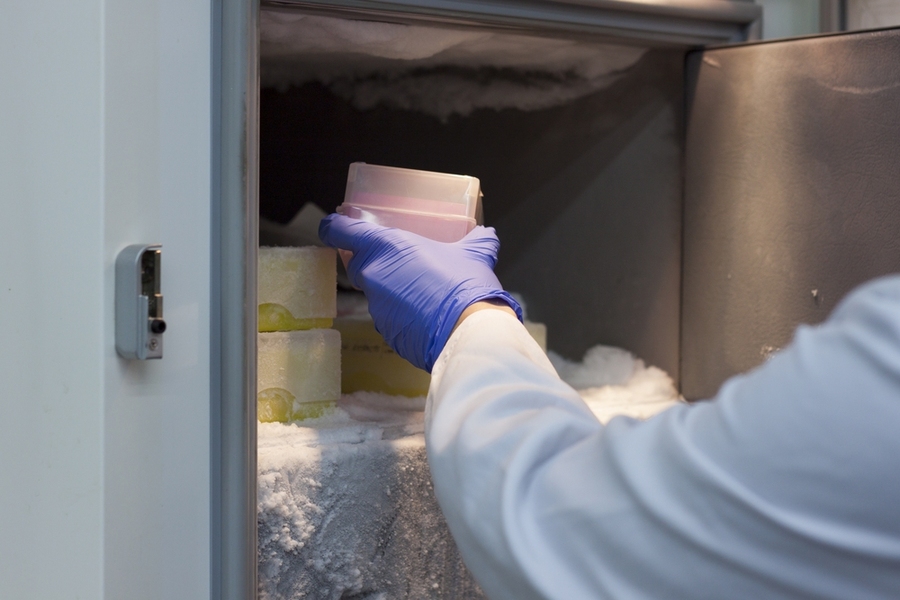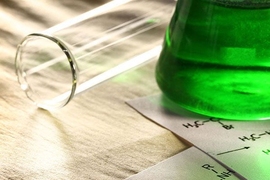This spring, nine MIT laboratories participated in the Institute’s first-ever Freezer Challenge, a friendly competition to encourage sustainable sample storage and freezer management practices. The labs’ combined efforts saved an estimated 86,892 metric tons equivalent of greenhouse gases, and $16,769 in energy costs.
The challenge was run through the MIT Green Labs initiative, a program coordinated by the Office of Environmental Health and Safety (EHS), the Department of Facilities, the Office of Sustainability (MITOS), and My Green Lab – a national nonprofit focused on improving the sustainability of scientific research. MITOS project manager Emma Corbalan organized the competition, which was modeled on the North American Laboratory Freezer Challenge, an international contest run by My Green Lab and the International Institute for Sustainable Laboratories (I2SL).
Six of the nine MIT labs submitted their results from the challenge to My Green Labs and are in the running for the North American Challenge prizes, which will be awarded at the 2017 I2SL Conference in Boston this October.
“We’ve worked with My Green Lab for several years on the MIT Green Labs program, and Allison Paradise, the executive director, has really been a champion of energy-saving options for our laboratories,” says Niamh Kelly, EHS officer and one of the coordinators of MIT Green Labs. “So this past January, she spearheaded the idea of having a Freezer Challenge and we worked to get the labs involved.”
Lab teams were awarded points in several categories including good management practices such as defrosting freezers, cleaning out freezers and refrigerators, inventorying samples, and storing samples at high density, as well as temperature tuning by determining the appropriate storage temperatures for samples and adjusting ultra-low-temperature freezers accordingly. Studies have shown that setting freezers to -70 degrees C instead of -80 C can lead to a nearly 40 percent energy reduction.
Points were also awarded for retiring old units or replacing them with more energy-efficient models, as well as adopting cutting-edge sample storage practices like room temperature storage, barcoding samples, and sharing storage space. Laboratories were given room to experiment and be creative with how they chose to reduce freezer energy demands.
“While we encouraged the competitive spirit, we wanted the participants to see this as a chance to become a better functioning unit,” Kelly says. “Labs are more efficient and generally safer in their practices when they are thinking of things holistically, in terms of the materials that they’re using, the equipment that they’re buying, when things are on, and when things are off. A more communicative lab, one that is being intentional and thoughtful about their research, is a safer lab.”
“The Freezer Challenge not only encouraged our lab to perform freezer maintenance and inventorying, but also provoked a collaborative effort with neighboring labs that resulted in the adoption of new freezer management practices within our building,” says Keven Dooley, a research technician in the Department of Biology’s Chisholm Lab.
“The roles of EHS, Facilities, and all of the laboratories fit together to make this project successful,” says Pam Greenley, associate director of EHS’s Environmental Management Program and MIT Green Labs coordinator. “EHS provided a framework to make sure that these new freezer management practices stick, so if a lab’s sustainability champion moves on, the lab continues to think actively about sustainability in the ways they conduct their research.”
Kelly also said that MIT Green Labs hopes to work more closely with MIT’s procurement staff to encourage more energy efficient and sustainable laboratory supplies be accessible for lab members to purchase.
“The Freezer Challenge is part of a much larger movement, through MIT Green Labs and beyond. It’s not just about one person or one lab getting rid of an old freezer, although that is certainly a good start; it’s about a shift in the way we think about every step of the research process,” Kelly says.
Highlights from the 2017 MIT Freezer Challenge (Jan. 15 – May 15):
- One hundred fourty three freezers units were involved in the challenge.
- The combined team of the Sharp and Bhatia Laboratories within the Koch Institute modified the largest number of cold storage units: a total of 45.
- Sixty-seven freezers were defrosted or had coils cleaned.
- Fifty five freezers had inventory systems created to remove and consolidate samples.
- Three units had samples that were moved to a warmer storage temperature.
- Ten older units were retired or replaced with more efficient models.
- Eight freezers were chilled up from -80 C to -70 C.
- The Imperiali Lab in the departments of Chemistry and Biology installed a Styrofoam insulator into an icebox to conserve dry ice shipments and reduce CO2 emissions.
- The Lauffenburger Lab in the Department of Biological Engineering changed a cryobox divider from 9x9 to 10x10; increasing the capacity of the box makes more efficient use of freezer space.
- The Niles Lab in the Department of Biological Engineering purchased a smaller freezer for frequently accessed enzymes to reduce the number of times the larger freezer is opened.
For more information about conservation efforts in MIT labs visit greenlab.mit.edu, or contact Pam Greenley or Niamh Kelly in EHS.







